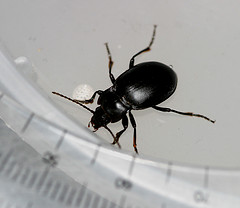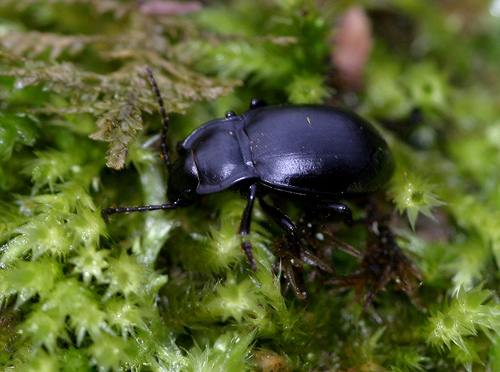Habitat, Geography, and Interactions
 Metrius
contractus can be found crawling in the forests of California
and in many other parts of the United states. Metrius contractus
is actually the only American species belonging to the genus
Metrius (Eisner et al. 1977, Eisner et al.
2000). They can also be found in Europe and other parts of
North America (Agosta 1996). The bombardier beetle dwells in temperate grasslands and temperate woodlands because it
is important for the beetle to have access to decomposing
matierals for its
reproduction and for its overall survival due to the high
amount of moisture found in these kinds of environments (NWF 2013).
Temperate grasslands have many
kinds of leaves and grasses that offers a great place of
protection for Metrius contractus (Campbell et al.
2008). Bombardier beetles can
surprisingly be found in deserts and savannas (UTEP 2007); however, there is a preference for the beetle to be in a
temperate climate so it can be exposed to a highly moisturized
environment.
Metrius
contractus can be found crawling in the forests of California
and in many other parts of the United states. Metrius contractus
is actually the only American species belonging to the genus
Metrius (Eisner et al. 1977, Eisner et al.
2000). They can also be found in Europe and other parts of
North America (Agosta 1996). The bombardier beetle dwells in temperate grasslands and temperate woodlands because it
is important for the beetle to have access to decomposing
matierals for its
reproduction and for its overall survival due to the high
amount of moisture found in these kinds of environments (NWF 2013).
Temperate grasslands have many
kinds of leaves and grasses that offers a great place of
protection for Metrius contractus (Campbell et al.
2008). Bombardier beetles can
surprisingly be found in deserts and savannas (UTEP 2007); however, there is a preference for the beetle to be in a
temperate climate so it can be exposed to a highly moisturized
environment.
They are primarily active during the night (Agosta 1996). This is the optimal time for the beetle to search for food, such as tiny insects (UTEP 2007). Bombardier beetles consume an interesting diet, including larvae of moths. They also eat the larvae of other beetles (Agosta 1996). To learn more about beetles, check out Insect World!
 The bombardier beetle is not exactly the most
friendly beetle thanks to its
ingenious chemistry.
Since this clever beetle has evolved an excellent strategy in
chemistry, the jet stream emitted from the posterior end of the
beetle makes the task of scaring predators off a lot easier (Eisner et al. 1990). The beetle
attacks many kinds of species, such as ants and frogs (Eisner et
al. 1977). Interestingly, when a bombardier beetle sprays
at a human that is holding the bug, the spray causes the skin to tan
due to the complex chemicals
that make up the spray (Eisner et
al. 1977). The beetle also emits a strong and rather
unpleasant smell when it sprays to defend itself (UTEP 2007). While it may be proficient in protecting
itself, the bombardier beetle is slow to get away from predators,
hence why its spray is so helpful (Eisner et al. 2000).
This is also why it is important for bombardier beetles to live in
temperate grassland environments. This type of environment
provides a place of protection for the beetle if it needs to avoid
predators (NWF 2013).
The bombardier beetle is not exactly the most
friendly beetle thanks to its
ingenious chemistry.
Since this clever beetle has evolved an excellent strategy in
chemistry, the jet stream emitted from the posterior end of the
beetle makes the task of scaring predators off a lot easier (Eisner et al. 1990). The beetle
attacks many kinds of species, such as ants and frogs (Eisner et
al. 1977). Interestingly, when a bombardier beetle sprays
at a human that is holding the bug, the spray causes the skin to tan
due to the complex chemicals
that make up the spray (Eisner et
al. 1977). The beetle also emits a strong and rather
unpleasant smell when it sprays to defend itself (UTEP 2007). While it may be proficient in protecting
itself, the bombardier beetle is slow to get away from predators,
hence why its spray is so helpful (Eisner et al. 2000).
This is also why it is important for bombardier beetles to live in
temperate grassland environments. This type of environment
provides a place of protection for the beetle if it needs to avoid
predators (NWF 2013).
While it may seem that Metrius contractus is invincible because of its potent chemical spray, there are other organisms such as the Orb-weaving spider that may successfully attack and capture the beetle to feed on it (Eisner et al. 1976). The talented spider does so, according to Eisner (Eisner et al. 1976), by first attacking the beetle without hesitation. This is very important for the spider since Metrius contractus cannot proficiently avoid predators since it moves very slow. The spider then creates a silky layer around the beetle, which protects the spider from the beetle's defensive tactic (Eisner et al. 1976). Experiments performed by Eisner (Eisner et al. 1976) revealed that the spider would occasionally back away from the beetle since the beetle does discharge a very toxic spray; however, the beetle was no match for the spider, and the spider continued to create its silky trap. The spider would then bite the beetle, secrete its poisons, and eat it (Eisner et al. 1976).
Refresh your knowledge on Classification or move on to Form and Function!

